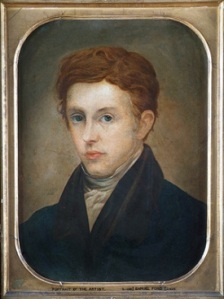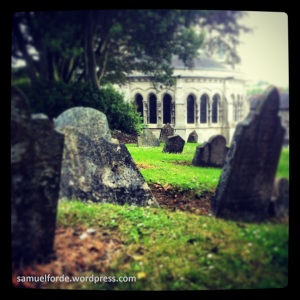Today marks the 185th anniversary of Samuel Forde’s death. At just twenty-three, this makes him one of Ireland’s true lost talents. Although his limited portfolio reflects his floruit, it promises what could have been a timeless talent. Quite apart from his technical ability, his engagement with other mediums like literature, and indeed an extant Cork tradition of art, reveals a curious and independent mind unwilling simply to follow the trends and zeitgeists of the day. As that is the focus of our investigation, Mike and I have devoted this post to marking Forde’s memory rather than his work.

Samuel Forde’s Self-Portrait (1828, oil on board). Image: © Crawford Art Gallery, Cork. Photo: Dara McGrath.
Knowing at twenty-three that death is imminent is something none of us want to imagine, but Forde’s experience has been a primary point of reference for us from the very start. We don’t know exactly when, or indeed where, Forde contracted TB, but he first speaks of his affliction in October 1827. His condition appears to have deteriorated steadily during late 1827 and spring of 1828, to the point where he is seriously debilitated by March and regularly commenting on his weakened state. His awareness of what lay ahead is seen in the fervent burst of energy that saw him complete busts of Milton and Shakespeare for exhibition, recorded in his final diary entry on 17 May. However, the dedication he showed to Fall of the Rebel Angels in his final weeks is nothing short of exemplary; working on the canvas night and day, even painting by candlelight to pin down as much of his vision as he could before he became too weak to continue. His final diary entry reveals a sincere regret at his own mortality, and a disappointment in work to be left unfinished by a life cut short. It remains one of the most poignant things we have ever read.
I am very weak.
For us, these few words capture so much of the human spirit: a drive to create, to realise an ambition even against the ultimate odds, a love for one’s art that exceeds even their care for life itself, and the desire to leave a legacy—to be gone but not forgotten. Yet this has so nearly been Forde’s fate: ‘Fall’ lost for so long, thankfully recovered and restored, his sketches unseen, and his life reduced to snippets from his diary or the observations of contemporaries. The man himself leaves us so little, not even a grave or memorial to tie his life to his legacy. That is why we came to St Fin Barre’s churchyard today to visit the place where Forde would have been laid to rest, and at least mark the life behind his legacy.
June 29th, feast day of Ss Peter and Paul.


